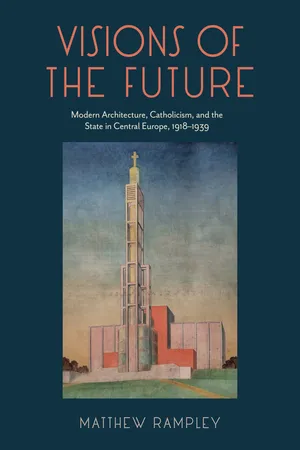
Visions of the Future
Modern Architecture, Catholicism, and the State in Central Europe, 1918–1939
- English
- PDF
- Available on iOS & Android
Visions of the Future
Modern Architecture, Catholicism, and the State in Central Europe, 1918–1939
About this book
Some of the most striking examples of modernist architecture are churches, yet they have seldom been subject to extended critical analysis. In this book, Matthew Rampley provides just such an analysis, focusing on the Catholic Church in interwar Austria, Czechoslovakia, and Hungary.
A powerful institution in the Habsburg Empire, the Catholic Church continued to be a central social, political, and cultural agent after 1918, working in alliance with political parties and national governments to promote visions of a new national culture. As a result, church building took on an important ideological and political function. Rampley's study is set against the backdrop of two interrelated issues: the role of architecture in the Catholic Church's response to an increasingly secular modernity, and church architecture as part of the Church's attempts to shape social and political life in the states that emerged after the collapse of Austria-Hungary. Rampley also examines the aesthetic, cultural, and political contexts that informed architectural projects, including the conflict between Catholicism and social democracy, the embrace of fascism, Catholic theories of technology, and discourses of regionalism and ruralism.
In bringing to light an untold chapter in the history of modern architecture, this book also engages in methodological reflection on the implications of the study of modern church architecture for the historiography of modernism. This book will appeal to students and scholars of architectural history, religious and political history, and interwar Central European history.
Frequently asked questions
- Essential is ideal for learners and professionals who enjoy exploring a wide range of subjects. Access the Essential Library with 800,000+ trusted titles and best-sellers across business, personal growth, and the humanities. Includes unlimited reading time and Standard Read Aloud voice.
- Complete: Perfect for advanced learners and researchers needing full, unrestricted access. Unlock 1.4M+ books across hundreds of subjects, including academic and specialized titles. The Complete Plan also includes advanced features like Premium Read Aloud and Research Assistant.
Please note we cannot support devices running on iOS 13 and Android 7 or earlier. Learn more about using the app.
Information
Table of contents
- COVER Front
- Copyright Page
- Table of Contents
- Acknowledgments
- Introduction
- Notes to Introduction
- Chapter 1: “A Beautiful Future ”Reading the Past, Reclaiming the Present
- Notes to Chapter 1
- Chapter 2: In What Style Shall We Build ? Reaction and Modernism in the Church
- Notes to Chapter 2
- Chapter 3: The Suspension of History Modernist Medievalisms
- Notes to Chapter 3
- Chapter 4:The Question of Technology Catholic Responses to Functionalist Architecture
- Notes to Chapter 4
- Chapter 5: Fascinating Fascism Aura, Myth, and Cultural Diplomacy
- Notes to Chapter 5
- Chapter 6: Deproletarianizing the Poor Churches, Mass Politics, and the City
- Notes to Chapter 6
- Chapter 7: Building Utopia Towns, Villages, and the Countryside
- Notes to Chapter 7
- Chapter 8: Values, Object Choice, Method Religious Architecture and the Historiography of Modernism
- Notes to Chapter 8
- Notes
- Bibliography
- Index